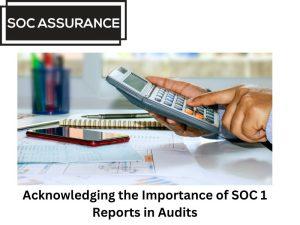
In today’s interconnected business landscape, data security and integrity are of paramount importance. As organizations handle sensitive financial information and personally identifiable data, stakeholders demand assurance that their systems and controls are robust and reliable. This is where SOC 1 reports come into play.
What is a SOC 1 Report?
A SOC 1 report, also known as a Service Organization Control 1 report, is an essential component of audit procedures. It provides valuable insights into the internal controls and processes of service organizations that are relevant to their clients’ financial reporting. These reports are conducted by independent auditors to evaluate the design and effectiveness of the controls in place.
Significance of SOC 1 Reports
- Client Confidence: Clients and stakeholders rely on SOC 1 reports to ensure that the service organization they are dealing with has proper controls in place. This not only builds trust but also helps clients meet their own compliance requirements.
- Regulatory Compliance: Many industries are subject to stringent regulatory standards. A SOC 1 report helps service organizations demonstrate compliance with regulations, making it easier to navigate the complex regulatory landscape.
- Risk Management: By undergoing a SOC 1 audit, organizations identify and mitigate risks in their processes. This leads to better risk management strategies and a reduced likelihood of data breaches or financial irregularities. Check Out :- Iso 27001 Audit Report
- Efficient Auditing: For client organizations, relying on the SOC 1 reports of their service providers can streamline their own audit processes. This is because they can assess the controls of their service providers without needing to perform detailed assessments themselves.
Types of SOC 1 Reports
There are two types of SOC 1 reports:
- SOC 1 Type I: This report evaluates the design of controls at a specific point in time. It assesses whether the controls have been suitably designed to achieve their objectives.
- SOC 1 Type II: This report goes a step further by assessing not just the design but also the operational effectiveness of controls over a specified period, typically six to twelve months.
How to Obtain a SOC 1 Report
- Engage an Auditor: Start by engaging a qualified and independent auditor who specializes in SOC 1 audits.
- Assessment: The auditor will assess the organization’s controls, reviewing their design and implementation. Also Read :- Cyber Security Advisory Alberta
- Testing: In the case of a SOC 1 Type II report, the auditor will test the controls’ operational effectiveness over a defined period.
- Report Generation: After the assessment and testing, the auditor will generate a SOC 1 report, detailing their findings, conclusions, and recommendations.
In an age where data breaches and financial fraud can have far-reaching consequences, SOC 1 reports are a beacon of assurance for businesses and their stakeholders. These reports offer insights into the controls that safeguard sensitive information and financial transactions, making them a critical component of the modern audit landscape.



